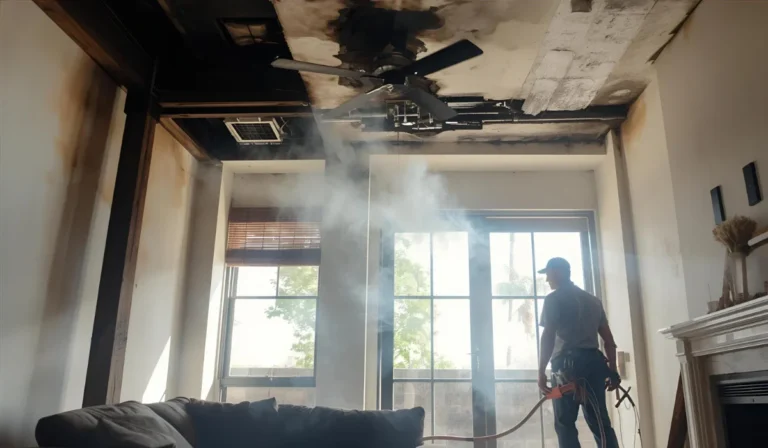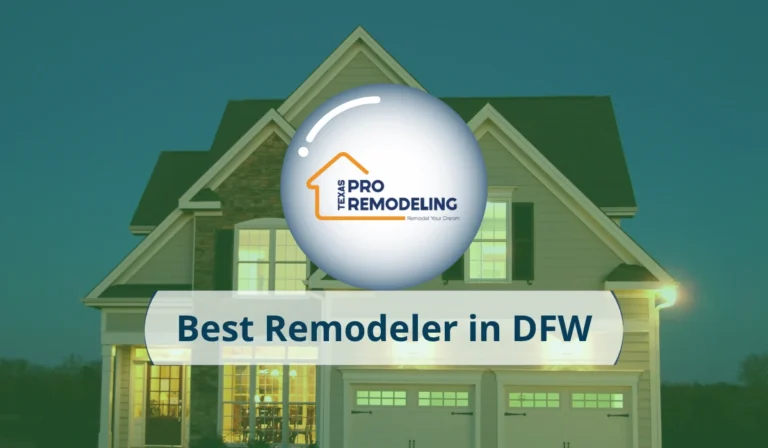The time it takes for smoke odors to vanish after a professional cleaning service changes for every property. Generally, homeowners can expect the smell to last anywhere from a few weeks to several months. This duration depends greatly on the fire’s severity. How fast the restoration team starts the cleanup process matters greatly. Odor persistence is also high when smoke deeply enters materials like wood and fabric. Expert companies use specialized tools to shorten this timeline, including ozone treatments, thorough deep cleaning, and thermal fogging.
The invisible fight to eliminate fire damage odors can be more frustrating than the fire itself. Even after professionals remove all soot, odor molecules hide in walls and air systems. This expert guide breaks down why the smell stays and gives you proven, advanced solutions to eliminate the odor for good.
Key Takeaways
|
Why Smoke Odor Lingers After Professional Soot Cleanup
Lingering smoke smell is a common and frustrating problem for homeowners after a fire. Even when professional teams remove all visible soot, the odor particles remain trapped deep inside materials. Understanding why this smell stays is the first step toward complete removal.
Smoke is not just air. Smoke contains microscopic particles and Volatile Organic Compounds (VOCs). These particles come from burning materials like plastic, wood, and fabric.
1. Smoke Penetrates Porous Materials
Porous materials absorb smoke deep into their structure. This absorption acts like a sponge for the odor.
- Drywall and Plaster: These materials are highly porous. Smoke particles easily settle into their tiny air pockets.
- Wood and Framing: Wood is fibrous. Smoke odor gets trapped deep in the grain of the subfloor, wall studs, and joists.
- Carpets and Upholstery: Fabrics and padding hold soot particles tightly. Washing surfaces often does not remove the smell from the deeper layers. Is the smell of smoke permanent? No, the smell is not permanent, but it needs advanced treatment to remove it from these trapped areas.
2. Contamination of the HVAC System
The Heating, Ventilation, and Air Conditioning (HVAC) system spreads the odor throughout the entire structure.
- Soot enters the air ducts during the fire.
- The furnace, fan coil, and ductwork become coated with odor-carrying residue.
- Every time the air system turns on, it pushes these particles and smells back into every room.
- Air duct cleaning helps with smoke smell. Yes, professional HVAC cleaning is necessary to stop the system from recontaminating the air.
3. The Smoke Type Makes a Difference
The type of material burned affects the smell’s persistence.
- Wet Smoke (from low-heat, smoldering fires): This smoke leaves a greasy, sticky residue. The residue bonds strongly to surfaces, making it difficult to clean and smell longer.
- Synthetic Materials (plastics, foam): These materials release strong, chemical-based VOCs. These chemical smells are extremely difficult to neutralize and require specialized methods.
Proven Solutions to Completely Eliminate Lingering Smoke Smell
Professional restoration involves two main phases: cleaning and deodorization. If the smell remains after the initial cleanup, the deodorization phase needs more intensive, advanced methods.
Phase 1: Deep Cleaning and Contaminant Removal
Professionals must first remove the source of the odor—the soot and fire residue.
- HEPA Vacuuming: Special HEPA (High-Efficiency Particulate Air) vacuums remove fine soot particles without releasing them back into the air.
- Chemical Sponges: These specialized dry sponges clean soot from surfaces like walls and ceilings without smearing the greasy residue.
- Thorough Washing: All surfaces, including walls, ceilings, and inside kitchen cupboards, need washing with commercial-grade cleaning agents.
Phase 2: Advanced Deodorization Techniques
Once surfaces are clean, powerful tools neutralize the trapped odor molecules. How do professional cleaners get rid of smoke smell? They use these proven atmospheric treatments:
| Technique | Function | Best Use Case |
| Ozone Treatment | Ozone generators produce O3, a molecule that breaks down odor-causing chemical compounds at the molecular level. | Eliminating severe, deeply embedded odors like cigarette smoke throughout an entire building. (Note: The area must be vacated during treatment.) |
| Thermal Fogging | A heated deodorizer creates a fine fog that mimics smoke. This fog penetrates walls, fabrics, and air pockets, neutralizing the trapped odor. | Reaching odor sources deep inside walls, vents, and inaccessible crevices. |
| Hydroxyl Generators | These machines create hydroxyl radicals (OH), which break down odor molecules safely. | Continuous air scrubbing in occupied areas, especially during the cleaning process itself. |
| Sealing (Encapsulation) | Applying an odor-locking primer or sealant (like an oil-based shellac) to porous surfaces (like subfloors or wall studs) permanently locks the odor inside. | Final step for surfaces that cannot be completely removed, such as structural framing or duct interiors. |
Practical Steps to Stop Smoke Odor from Coming Back
Addressing hidden contamination is the key to preventing the smoke smell from returning, especially the lingering odors from sources like cigarette smoke.
1. Treat the Air System and Vents
The HVAC system is the most common reason the smell comes back.
- Professional Duct Cleaning: A professional must clean all air ducts using specialized rotary brushes and high-powered vacuum systems.
- Filter Replacement: Change the HVAC air filter immediately after the fire. Continue changing it often (every 1-3 months) for the next year to catch residual particles.
- Wipe Vents: Wipe down the visible air vents and registers with a cleaning solution.
2. Address Hidden Structural Areas
Smoke often hides in concealed spaces.
- Attics and Crawlspaces: Smoke travels upwards. Soot and odor can settle on attic insulation and exposed wood. These areas often require thermal fogging or sealing.
- Electronics Inspection: Soot can be corrosive. Every electronic device should be opened up and thoroughly visually inspected by a professional to prevent long-term damage and hidden odor.
3. DIY Absorbers and Immediate Action
For small incidents or immediate action, simple absorbers help reduce the odor strength quickly.
- Ventilation: Open windows and use fans to circulate fresh air immediately.
- Baking Soda and Vinegar: Baking soda absorbs odors from carpets and furniture. Open bowls of vinegar or activated charcoal placed in rooms help neutralize ambient smoke smells.
- Quick Action: The longer you wait to clean up after a fire, the harder it is to remove the smell. Act fast to prevent permanent staining and deep absorption.
Conclusion
Successfully eliminating persistent smoke odor requires moving beyond surface cleaning. As this guide shows, the odor persists because microscopic soot and chemical particles penetrate deep into porous materials like wood and drywall, and silently recirculate through the HVAC system. To achieve a truly fresh, clean result, homeowners must ensure the restoration process includes specialized, advanced steps. This means confirming the use of techniques like thermal fogging to reach hidden crevices, ozone treatment to neutralize odor molecules at the source, and encapsulation (sealing) for structural elements. By understanding why the smell stays and insisting on these proven methods, you ensure the fire damage is truly gone, restoring your home to a safe and comfortable state.
FAQs
Does Soot Smell Go Away?
Yes, the soot smell goes away, but it requires thorough and specific cleaning and deodorization methods. Simple ventilation is often not enough because soot particles bond to materials and release VOCs for a long time.
How Long Does It Take For The Smell Of Smoke To Go Away?
The timeline varies from a few weeks for very minor, localized incidents up to several months for severe fires where smoke entered porous materials and the HVAC system. Professional intervention significantly shortens this duration.
Is The Smell Of Smoke Permanent?
No, the smell of smoke is not permanent. However, without professional ozone or thermal fogging treatments, the odor can linger in wood, drywall, and upholstery for years because the odor molecules remain physically trapped.
How To Get Rid Of Soot Odor?
The most effective process involves: 1) removing the soot source with HEPA vacuuming and specialized washing; 2) neutralizing trapped odors using professional methods like ozone or thermal fogging; and 3) sealing affected structural areas with odor-locking primers.
Does Air Duct Cleaning Help With Smoke Smell?
Yes, air duct cleaning is crucial. Soot travels through the air system, contaminating the ducts and vents. Cleaning the HVAC system stops the ducts from reintroducing the smoke odor into the living spaces.
Can Detailers Get Rid Of Smoke Smell?
Detailing can significantly improve the sharp, heavy smoke smell in a vehicle. However, complete removal often requires the use of a professional ozone machine run repeatedly over several days, as smoke penetrates the foam and fabric deep inside the car’s components.







